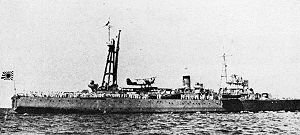- Okinoshima (1936)
-
Okinoshima 
El Okinoshima en 1937.Banderas 
Historial Astillero Harima (Hyōgo) Clase Único Tipo Minador Autorizado 1931 Iniciado 27 de septiembre de 1934 Botado 15 de noviembre de 1935 Asignado 30 de septiembre de 1936 Baja 25 de mayo de 1945 Destino Hundido el 12 de mayo de 1942 Características generales Desplazamiento 4.400 toneladas, 4.920 toneladas a plena carga[1] Eslora 113 metros entre perpendiculares, 119,29 metros en la línea de flotación Manga 15,74 metros Calado 5,49 metros Armamento • Cuatro cañones de 140 mm • Dos cañones de 80 mm
• 500 minas marinasPropulsión Cuatro calderas Kampon, dos turbinas, dos hélices Potencia 9.000 shp Velocidad 20 nudos Autonomía 9.000 millas náuticas a 10 nudos Aeronaves Un hidroavión Kawanishi E7K Equipamiento aeronaves Una catapulta El Okinoshima (沖島?) fue un tipo especial de minador pesado de la Armada Imperial Japonesa, del que sólo se construyó una unidad.
Contenido
Diseño y desarrollo
El Okinoshima tenía como misión principal el despliegue de minas, pero dada su gran autonomía, así como un desplazamiento y armamento comparables a los de un crucero ligero, también podía realizar misiones de escolta. Su escasa velocidad le impedía ser una unidad de combate de primera línea. Contaba también con otra característica compartida con los cruceros, y era la capacidad de transportar un hidroavión, con una catapulta para lanzarlo.
Si bien no se construyeron más minadores con su diseño, el posterior editar] Historial de servicio
Desde el inicio de la Segunda Guerra Mundial formó parte de las fuerzas de invasión de Makin, Tarawa, Rabaul, Kavieng, Lae y Tulagi. Tras desembarcar tropas durante la invasión de Tulagi el 4 de mayo de 1942, fue dañado por un ataque aéreo de aparatos provenientes del USS Yorktown, quedando sin propulsión y siendo remolcado hasta Rabaul por el transporte Kinryu Maru.
El 12 de mayo de 1942, cerca de Nueva Bretaña, fue localizado por el submarino estadounidense editar] Referencias
- ↑ Jentschura indica un desplazamiento máximo de 5.000 toneladas, mientras que Chesneau y Nishida coinciden en limitarlo 4.920 toneladas.
Bibliografía
- Jentschura, Hansgeorg; Jung, Dieter; Mickel, Peter (en inglés). Warships of the Imperial Japanese Navy, 1869-1945. Naval Institute Press. p. 200. ISBN 0-87021-893-X.
- Chesneau, Roger, ed (en inglés). All the World´s Fighting Ships 1922-1946. Conway Maritime Press Ltd.. p. 208. ISBN 0-85177-1467.
- Hackett, Bob; Kingsepp, Sander (1998-2010). «IJN Minelayer OKINOSHIMA: Tabular Record of Movement» (en inglés). Combined Fleet. «Registro de actividad del Okinoshima.».
- Nishida, Hiroshi (2003). «Okinoshima minelayer» (en inglés). Materials of IJN. «Información sobre el Okinoshima.».
Wikimedia foundation. 2010.
